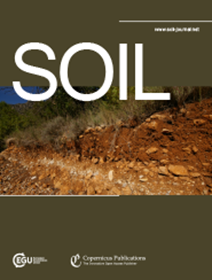Pooled error variance and covariance estimation of sparse in situ soil moisture sensor measurements in agricultural fields in Flanders
IF 4.3
2区 农林科学
Q1 SOIL SCIENCE
引用次数: 0
Abstract
Abstract. Accurately quantifying errors in soil moisture measurements from in situ sensors at fixed locations is essential for reliable state and parameter estimation in probabilistic soil hydrological modeling. This quantification becomes particularly challenging when the number of sensors per field or measurement zone (MZ) is limited. When direct calculation of errors from sensor data in a certain MZ is not feasible, we propose to pool systematic and random errors of soil moisture measurements for a specific measurement setup and derive a pooled error covariance matrix that applies to this setup across different fields and soil types. In this study, a pooled error covariance matrix was derived using soil moisture sensor measurements from three TEROS 10 (Meter Group, Inc., USA) sensors per MZ and soil moisture sampling campaigns conducted over three growing seasons, covering 93 cropping cycles in agricultural fields with diverse soil textures in Belgium. The MZ soil moisture estimated from a composite of nine soil samples with a small standard error (0.0038 m3 m−3) was considered the “true” MZ soil moisture. Based on these measurement data, we established a pooled linear recalibration of the TEROS 10 manufacturer's sensor calibration function. Then, for each individual sensor as well as for each MZ, we identified systematic offsets and temporally varying residual deviations between the calibrated sensor data and sampling data. Sensor deviations from the “true” MZ soil moisture were defined as observational errors and lump both measurement errors and representational errors. Since a systematic offset persists over time, it contributes to the temporal covariance of sensor observational errors. Therefore, we estimated the temporal covariance of observational errors of the individual and the MZ-averaged sensor measurements from the variance of the systematic offsets across all sensors and MZ averages, while the random error variance was derived from the variance of the pooled residual deviations. The total error variance was then obtained as the sum of these two components. Due to spatial soil moisture correlation, the variance and temporal covariance of MZ-averaged sensor observational errors could not be derived accurately from the individual sensor error variances and temporal covariances, assuming that the individual observational errors of the three sensors in a MZ were not correlated with each other. The pooled error covariance matrix of the MZ-averaged soil moisture measurements indicated a significant autocorrelation of sensor observational errors of 0.518, as the systematic error standard deviation (σα‾= 0.033 m3 m−3) was similar to the random error standard deviation (σϵ‾= 0.032 m3 m−3). To illustrate the impact of error covariance in probabilistic soil hydrological modeling, a case study was presented incorporating the pooled error covariance matrix in a Bayesian inverse modeling framework. These results demonstrate that the common assumption of uncorrelated random errors to determine parameter and model prediction uncertainty is not valid when measurements from sparse in situ soil moisture sensors are used to parameterize soil hydrological models. Further research is required to assess to what extent the error covariances found in this study can be transferred to other areas and how they impact parameter estimation in soil hydrological modeling.法兰德斯农田稀疏原位土壤水分传感器测量的汇总误差方差和协方差估计
摘要。在概率土壤水文模型中,准确量化固定位置原位传感器测量土壤水分的误差对可靠的状态和参数估计至关重要。当每个油田或测量区域(MZ)的传感器数量有限时,这种量化变得特别具有挑战性。当从传感器数据中直接计算误差在某个MZ是不可实现的,我们建议汇集系统和随机误差的土壤湿度测量的特定测量设置,并得出一个汇集误差协方差矩阵,适用于该设置跨不同领域和土壤类型。在这项研究中,利用每MZ三个TEROS 10 (Meter Group, Inc., USA)传感器的土壤湿度传感器测量数据,以及在比利时不同土壤质地的农田中进行的三个生长季节的土壤湿度采样活动,得出了一个汇总误差协方差矩阵。由9个土壤样品复合估算的MZ土壤水分具有很小的标准误差(0.0038 m3 m−3),被认为是“真实的”MZ土壤水分。基于这些测量数据,我们建立了TEROS 10制造商传感器校准函数的池线性再校准。然后,对于每个单独的传感器以及每个MZ,我们确定了校准传感器数据和采样数据之间的系统偏移和随时间变化的剩余偏差。传感器与“真实”MZ土壤湿度的偏差被定义为观测误差,包括测量误差和表征误差。由于系统偏移持续一段时间,它有助于传感器观测误差的时间协方差。因此,我们通过所有传感器的系统偏移量和MZ平均值的方差来估计个体观测误差和MZ平均传感器测量值的时间协方差,而随机误差方差则来自合并残差的方差。然后得到总误差方差作为这两个分量的和。由于土壤湿度的空间相关性,假设一个MZ内3个传感器的单个观测误差不相关,则不能由单个传感器的误差方差和时间协方差准确地推导出MZ平均传感器观测误差的方差和时间协方差。mz平均土壤湿度测量值的汇总误差协方差矩阵表明,传感器观测误差具有显著的自相关性(0.518),系统误差标准差(σα - = 0.033 m3 - m - 3)与随机误差标准差(σα - = 0.032 m3 - m - 3)相似。为了说明误差协方差对概率土壤水文建模的影响,在贝叶斯逆建模框架中引入了一个混合误差协方差矩阵的案例研究。这些结果表明,当使用稀疏原位土壤湿度传感器的测量值来参数化土壤水文模型时,通常假设的不相关随机误差来确定参数和模型预测的不确定性是不成立的。本研究发现的误差协方差在多大程度上可以转移到其他领域,以及它们如何影响土壤水文建模中的参数估计,还需要进一步的研究。
本文章由计算机程序翻译,如有差异,请以英文原文为准。
求助全文
约1分钟内获得全文
求助全文
来源期刊

Soil
Agricultural and Biological Sciences-Soil Science
CiteScore
10.80
自引率
2.90%
发文量
44
审稿时长
30 weeks
期刊介绍:
SOIL is an international scientific journal dedicated to the publication and discussion of high-quality research in the field of soil system sciences.
SOIL is at the interface between the atmosphere, lithosphere, hydrosphere, and biosphere. SOIL publishes scientific research that contributes to understanding the soil system and its interaction with humans and the entire Earth system. The scope of the journal includes all topics that fall within the study of soil science as a discipline, with an emphasis on studies that integrate soil science with other sciences (hydrology, agronomy, socio-economics, health sciences, atmospheric sciences, etc.).
 求助内容:
求助内容: 应助结果提醒方式:
应助结果提醒方式:


